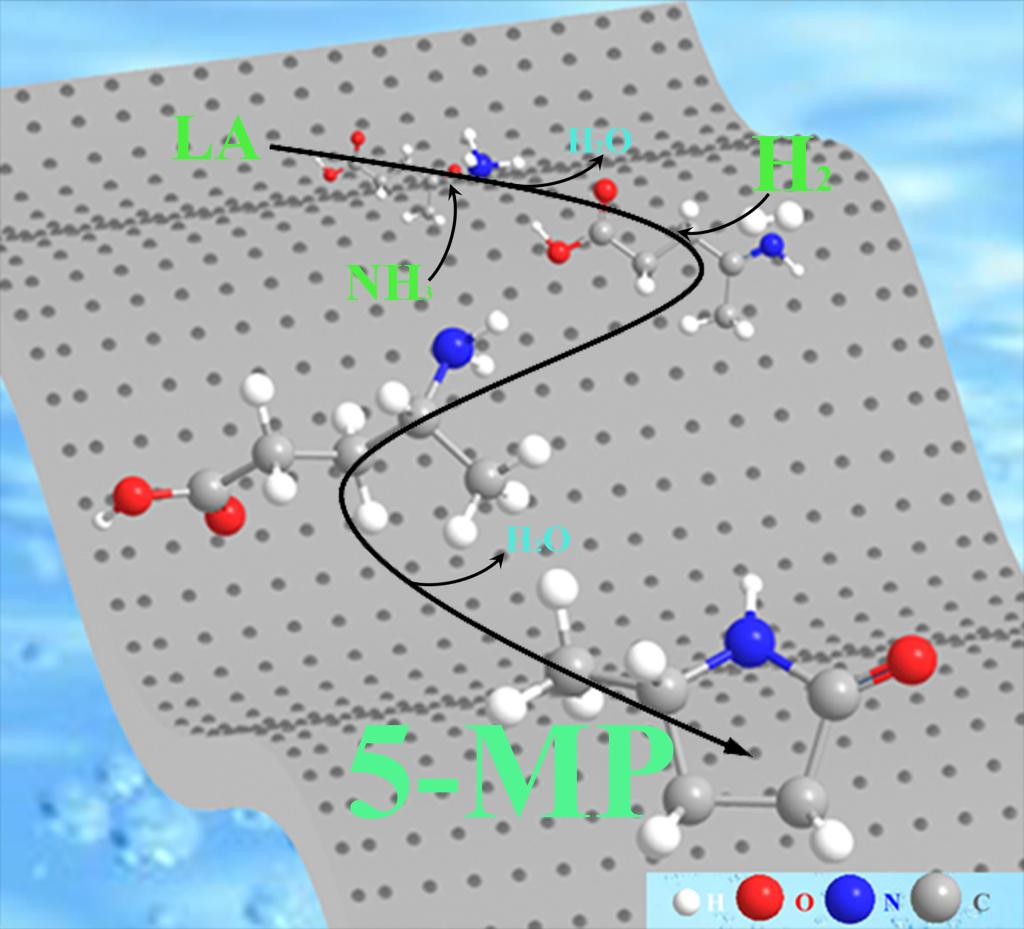还原胺化Synergistic catalysis of Co-Zr/CNx bimetallic nanoparticles enables reductive amination of bio-based levulinic acid
Recently, PhD student Mr Pei-dong Wu supervised by Profs. Hu Li and Zhen Fang published a research article in Advanced Sustainable Systems about bimetallic synergistic catalysis for reductive amination of bio-based levulinic acid.
Bimetallic synergy and carbon-nitrogen doping can contribute to enhanced catalytic activity due to the strong electronic state and unique geometrical structure. In this work, a series of biomass-derived Co-M bimetallic C-N doped catalysts (Co-M@Chitosan-X; M = Zr, Ni, Fe, Cu, In; X denotes the molar percentage of M) were prepared via simple oil bath reflow and annealing. The Co-Zr@Chitosan-X catalysts were determined to contain alloy (Co-Zr), metal-carbon bond (Co-C, Zr-C), metal-nitrogen bond (Co-N, Zr-N) and metal oxide (Co3O4, ZrO2) through a series of characterizations, in which graphite-coated alloys and metal oxides were catalytically active species. The doping of the second metal results in a significant enhancement for the number of active sites in the catalyst, and the d-band center is shifted toward a deviation from the Fermi energy level. Among the tested catalysts, Co-Zr@Chitosan-20 exhibited superior catalytic activity for the reductive amination of bio-based levulinic acid to 5-methyl-2-pyrrolidone in 99.3% selectivity and 92.8% yield. This non-noble metal bimetallic synergistic catalytic protocol opens an avenue for efficiently producing biomass-derived nitrogenous chemicals.
Related results were accepted in Advanced Sustainable Systems:
Pei-dong Wu, Hu Li *, Zhen Fang *, Synergistic catalysis of Co-Zr/CNx bimetallic nanoparticles enables reductive amination of bio-based levulinic acid, 2022, 2100321. https://doi.org/10.1002/adsu.202100321

Non-noble bimetallic nanoparticles (Co-Zr/CNx) were efficient for direct conversion of bio-based levulinic acid (LA) to 5-methyl-2-pyrrolidone (5-MP) in water at 130 °C. Synergistic role was found in the reductive amination process with high activity over a long period of time in one-pot reactions.
非贵金属双金属纳米粒子(Co-Zr/CNx)在130℃的水中能有效地将生物基乙酰丙酸(LA)直接转化为5-甲基-2-吡咯烷酮(5-MP)。在单锅反应中还原胺化过程中发现双金属催化剂长时间具有高活性。
博士生吴培栋在李虎教授和方真教授的指导下,在国际学术期刊Advanced Sustainable Systems发表研究性论文:
具有协同作用的Co-Zr/CNx双金属纳米颗粒催化
还原胺化生物质基乙酰丙酸
最近,博士生吴培栋在李虎教授和方真教授的指导下,在国际学术期刊Advanced Sustainable Systems (Q1; Impact factor: 6.271)上发表了一篇关于双金属协同催化生物基乙酰丙酸还原胺化的研究性论文。
双金属协同作用和碳氮掺杂有助于提高催化剂的催化活性,因为掺杂后催化剂的强电子态和独特的几何结构。在这项工作中,通过简单的油浴回流和高温退火制备了一系列生物质衍生的双金属碳氮掺杂催化剂(Co-M@Chitosan-X;M = Zr, Ni, Fe, Cu, In;X表示M的摩尔百分比)。通过一系列的表征,Co-Zr@Chitosan-X催化剂的组分被确定为含有合金(Co-Zr)、金属-碳键(Co-C、Zr-C)、金属-氮键(Co-N、Zr-N)和金属氧化物(Co3O4、ZrO2),其中石墨包覆的合金和金属氧化物是催化活性物种。第二种金属的掺入使催化剂的活性位点数量明显增加,并且d带中心向偏离费米能级的方向移动。在催化剂活性测试中,Co-Zr@Chitosan-20在还原胺化生物基乙酰丙酸为5-甲基-2-吡咯烷酮的过程中表现出卓越的催化性能,其中选择性为99.3%,收率为92.8%。这种非贵金属的双金属协同催化作用为有效生产生物质衍生的含氮化学品开辟了一条新的途径。
详情可见:
Pei-dong Wu, Hu Li *, Zhen Fang *. Synergistic catalysis of Co-Zr/CNx bimetallic nanoparticles enables reductive amination of bio-based levulinic acid, 2022, 2100321. https://doi.org/10.1002/adsu.202100321

